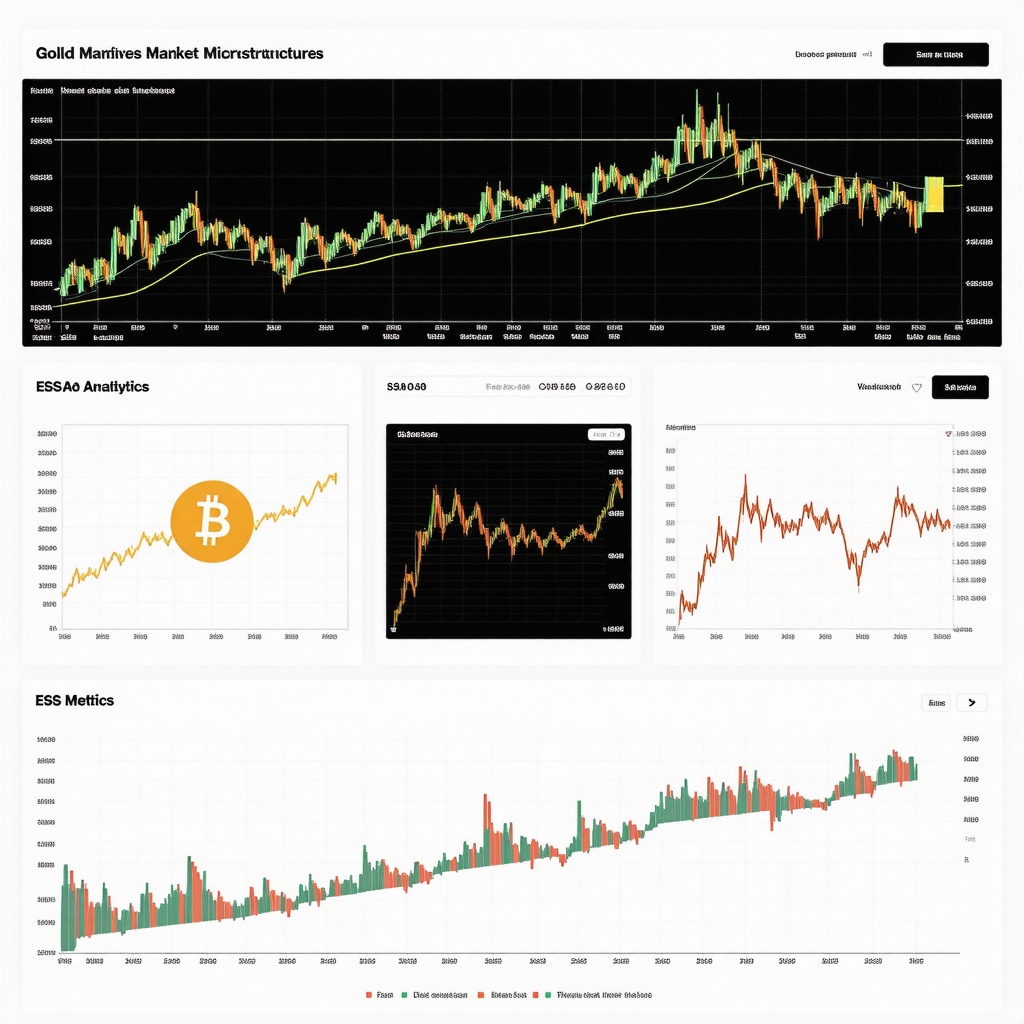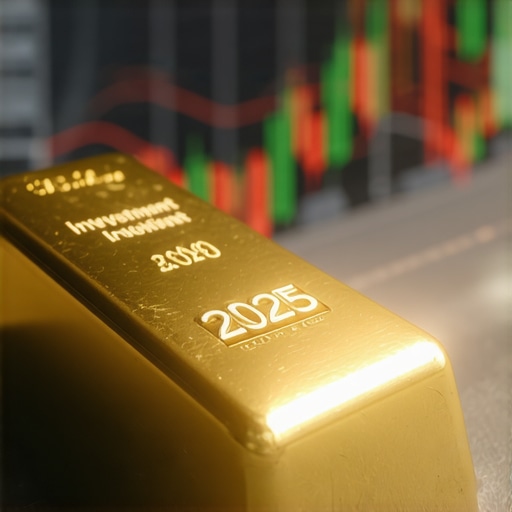Strategic Gold Investment Amid Economic Volatility: A Deep Dive
In the face of mounting economic uncertainty characterized by inflationary pressures, geopolitical tensions, and fluctuating currency markets, gold remains a timeless refuge for preserving wealth. However, navigating gold investments requires more than conventional wisdom; it demands a nuanced understanding of market dynamics, supply-demand intricacies, and portfolio integration strategies that optimize both safety and returns.
Analyzing Gold’s Role as a Hedge Against Inflation and Currency Depreciation
Gold’s intrinsic value as a hedge is complex and context-dependent. Inflation erodes fiat currency purchasing power, prompting savvy investors to allocate capital into tangible assets like gold. Yet, the effectiveness of gold as an inflation hedge varies with the nature of inflation and central bank policies. For instance, in periods of stagflation, gold often outperforms equities and bonds, but its performance may be muted in deflationary environments with tightening monetary policy. Incorporating macroeconomic indicators and understanding their influence on gold price trends is essential for timing investment decisions effectively.
What Are the Advanced Techniques to Optimize Gold Portfolio Allocation in Turbulent Markets?
Advanced investors leverage a diversified approach combining physical gold assets with financial instruments such as Gold Exchange-Traded Funds (ETFs), gold mining stocks, and futures contracts. Physical gold provides security and tangible value, while ETFs offer liquidity and ease of trading. Mining stocks, however, introduce operational risks but can amplify returns during bullish cycles. Employing a dynamic rebalancing strategy responsive to market volatility and geopolitical developments enhances portfolio resilience. Utilizing analytic tools to track gold demand trends and supply constraints further refines investment timing, as detailed in mastering gold market analysis.
Supply-Demand Dynamics: Understanding Global Gold Flows and Their Market Impact
The global gold market is influenced by central bank purchases, jewelry demand, investment flows, and mining output. Notably, central banks’ strategic reserves accumulation can signal long-term price direction, while shifts in consumer demand, especially in emerging markets, impact short-to-medium-term trends. Awareness of these factors, complemented by data from reputable sources such as the World Gold Council, empowers investors to anticipate price movements with greater precision. For a comprehensive overview, see World Gold Council’s Gold Demand Trends report.
Integrating Gold Investment Strategies with Broader Portfolio Objectives
Integrating gold into a balanced portfolio involves weighing its low correlation with equities and fixed income against liquidity needs and investment horizon. Strategic allocation percentages differ based on risk tolerance and economic outlook but generally range between 5% and 15%. Employing a mix of physical gold and liquid gold ETFs can optimize accessibility while preserving value. For investors seeking deeper insights into selecting appropriate gold investment vehicles, resources such as the best gold investment strategies to hedge against inflation provide expert guidance.
Explore More Expert-Level Gold Investment Techniques
To deepen your expertise, consider exploring advanced gold trading techniques that unlock sophisticated market maneuvers and maximize profit potential in volatile environments. Your contributions to professional discourse on gold investment strategies are also welcomed to foster a community of informed investors.
Leveraging Gold Derivatives and Alternative Instruments for Portfolio Enhancement
Beyond traditional physical gold and ETFs, sophisticated investors increasingly incorporate derivatives such as options and futures into their portfolios to hedge risk and capitalize on short-term price movements. Options provide asymmetric payoff profiles, allowing investors to benefit from gold’s upside while limiting downside exposure. Futures contracts enable precise exposure management and can be used to implement tactical asset allocation or arbitrage strategies. However, these instruments demand a high level of market knowledge and risk tolerance due to their complexity and leverage effects.
Moreover, alternative instruments like gold-backed cryptocurrencies and structured products are gaining traction, offering innovative ways to access gold exposure with enhanced liquidity and sometimes lower transaction costs. These novel vehicles also introduce regulatory and counterparty risks that require careful due diligence.
Decoding the Impact of Geopolitical Events on Gold Price Volatility
Geopolitical tensions remain a pivotal driver of gold price volatility. Conflicts, trade disputes, and political instability prompt investors to seek safe havens, often resulting in rapid gold price appreciation. However, the degree of sensitivity varies with event nature and market sentiment. For instance, sudden escalations in regional conflicts can trigger short-lived spikes, while prolonged uncertainty may sustain higher gold valuations. Understanding these dynamics enables investors to anticipate and respond to market shifts with informed agility.
How Can Investors Harness Sentiment Analysis and Machine Learning to Predict Gold Market Movements?
Recent advancements in data analytics have empowered investors to integrate sentiment analysis derived from news, social media, and economic reports into predictive models for gold price forecasting. Machine learning algorithms can detect subtle patterns and correlations that traditional analysis might overlook. By training models on historical price data alongside sentiment indicators, investors can generate probabilistic forecasts that enhance decision-making precision. While these techniques are not infallible, they represent a frontier in systematic gold market analysis, complementing fundamental and technical approaches. For a detailed exploration of integrating analytics into gold market strategies, see mastering gold market analysis.
Risk Management: Balancing Gold Exposure with Broader Asset Allocation
Effective gold investment strategy extends beyond acquisition to encompass rigorous risk management. Investors must continuously evaluate gold’s correlation with other portfolio components under varying market regimes to optimize diversification benefits. Employing stop-loss orders, setting exposure limits, and periodically rebalancing can mitigate downside risks while preserving upside potential. Additionally, monitoring liquidity constraints and timing exit strategies are crucial, especially when investing in physical gold or less liquid instruments.
By integrating these risk management practices, investors can harness gold’s unique properties while aligning with their overall financial goals and risk appetites.
Evaluating Environmental, Social, and Governance (ESG) Factors in Gold Investments
Growing investor emphasis on ESG criteria is reshaping the gold market landscape. Ethical sourcing, environmental impact of mining operations, and community relations influence corporate valuations and investor sentiment. Selecting gold mining stocks or funds with robust ESG practices can reduce reputational risk and align portfolios with sustainable investment mandates. Moreover, demand for responsibly sourced physical gold is rising, encouraging transparency and certification standards.
Investors aiming to incorporate ESG considerations should assess third-party certifications and company disclosures to ensure alignment with their values and risk frameworks. This approach not only supports sustainable development but may also enhance long-term investment resilience.
For beginners seeking foundational knowledge on gold investing, the essential tips for 2025 offer a practical starting point.
Join the Conversation: What Are Your Insights on the Future of Gold Investment Strategies?
We invite readers to share their perspectives and experiences regarding innovative gold investment techniques and risk management approaches. Your insights enrich the community and foster a deeper collective understanding of this complex asset class.
Harnessing Quantitative Models and Algorithmic Trading in Gold Markets
As financial markets evolve, the incorporation of quantitative models and algorithmic trading has revolutionized how investors approach gold investment. These methodologies process vast datasets encompassing price volatility, macroeconomic indicators, and geopolitical news to execute trades with precision and minimal latency. Quant models like the GARCH (Generalized Autoregressive Conditional Heteroskedasticity) framework enable refined volatility forecasting, critical for timing entry and exit points in gold futures and options markets. Algorithmic strategies, including momentum-based and mean-reversion algorithms, capitalize on microstructure inefficiencies, often inaccessible to traditional manual traders. However, the deployment of such sophisticated tools requires not only advanced programming expertise but also a deep understanding of market microdynamics and risk controls.
What Are the Pitfalls and Best Practices When Implementing Algorithmic Gold Trading Strategies?
While algorithmic trading offers speed and systematic discipline, pitfalls include overfitting models to historical data, ignoring regime shifts, and underestimating transaction costs. To mitigate these risks, investors should emphasize robust backtesting across multiple market cycles, incorporate adaptive learning mechanisms, and maintain stringent real-time monitoring. Additionally, integrating fundamental data such as central bank policy announcements and mining production reports into model inputs enhances predictive accuracy. Leading industry practitioners advocate for a hybrid approach that blends quantitative analysis with discretionary oversight to adapt to unforeseen geopolitical shocks and liquidity crunches, as highlighted in CFA Institute’s research on quantitative strategies.
Gold’s Nexus with Cryptocurrency: Exploring Synergies and Divergences
The intersection of gold and cryptocurrency presents a fascinating frontier in asset management. While gold is traditionally viewed as a tangible store of value, cryptocurrencies like Bitcoin offer decentralized digital scarcity, often earning the moniker “digital gold.” Investors increasingly consider the correlation dynamics between these assets to diversify portfolios and hedge against systemic risks. Notably, during periods of heightened market stress, Bitcoin’s price behavior has sometimes diverged from gold, reflecting differing investor bases and liquidity profiles. Moreover, the emergence of gold-backed tokens—digital assets pegged to physical gold holdings—combines the trust and stability of gold with blockchain’s transparency and transactional efficiency.
These innovations raise complex questions about custody, regulatory compliance, and counterparty risks. For instance, ensuring that gold reserves match token issuance requires rigorous auditing standards and third-party verification. Investors must perform due diligence on token issuers’ accreditation and the underlying smart contract security to avoid fraud or misrepresentation.
Integrating Environmental, Social, and Governance (ESG) Metrics with Gold Investment Risk Models
Incorporating ESG factors into gold investment is becoming increasingly sophisticated, extending beyond mere exclusionary screening toward holistic risk-adjusted performance models. Advanced ESG integration assesses how mining companies’ environmental footprints, labor practices, and governance structures influence operational risks, legal liabilities, and long-term profitability. For example, companies with subpar water management systems face heightened regulatory scrutiny and potential operational shutdowns, directly impacting their stock valuations and, consequently, the value of gold equities within portfolios.
Quantitative ESG scoring systems, combined with traditional financial metrics, enable investors to construct optimized portfolios that align with sustainability goals without sacrificing returns. Leading asset managers deploy multi-factor models that include ESG indicators alongside macroeconomic and technical variables, enhancing the signal-to-noise ratio in investment decisions. The MSCI research on ESG integration provides an exemplary framework for such advanced methodologies.
Gold Market Microstructure: Unpacking Liquidity, Bid-Ask Spreads, and Market Depth
Understanding the microstructure of gold markets is pivotal for executing large trades without adverse price impact. Market depth, bid-ask spreads, and order book dynamics fluctuate with trading venues (COMEX, OTC, LBMA) and times (e.g., Asian vs. European trading sessions). Liquidity can evaporate rapidly during geopolitical crises or macroeconomic shocks, causing slippage and volatility spikes. Sophisticated traders employ order-splitting algorithms and dark pool access to minimize market footprint and information leakage.
Moreover, the rise of electronic trading platforms has altered traditional gold market behaviors, introducing new participants such as algorithmic market makers and high-frequency traders. These actors contribute to tighter spreads but can also exacerbate flash crashes under stressed conditions. Mastering these nuances enables investors to refine execution strategies and cost management.
How Does Market Microstructure Influence Gold Price Discovery and Volatility?
Market microstructure intricately affects how gold prices incorporate new information, shaping volatility patterns. Fragmented liquidity across venues can lead to price dislocations and arbitrage opportunities, while the presence of informed traders accelerates price discovery. Conversely, liquidity shocks can cause transient price distortions, complicating valuation models. For a comprehensive analysis, see academic research on precious metals market microstructure.
Investors interested in mastering these complex facets of gold investment should engage with advanced literature and consider professional advisory services to tailor approaches that align with their risk tolerance and strategic objectives.
Decoding Liquidity Nuances and Algorithmic Trading in Gold Markets
Deepening the understanding of gold market microstructure reveals critical insights into liquidity dispersion, bid-ask spread dynamics, and order flow fragmentation across global trading venues such as COMEX, LBMA, and OTC markets. These facets critically influence execution costs and price slippage risks, particularly in volatile geopolitical or macroeconomic episodes. Algorithmic traders employ sophisticated order-splitting algorithms and utilize dark pools to minimize market impact and preserve anonymity, thus optimizing trade execution. The emergent role of electronic trading platforms and high-frequency market makers has led to compressed spreads but increased susceptibility to flash crashes, demanding advanced risk controls and adaptive algorithms.
How Can Integrating Market Microstructure Insights Enhance Algorithmic Gold Trading Performance?
Integrating granular microstructure data into algorithmic trading frameworks enables models to anticipate liquidity droughts and price dislocations, thereby refining signal generation and trade timing. Incorporating real-time order book analytics, trade flow imbalance indicators, and cross-venue arbitrage signals enhances the predictive accuracy of quantitative models. Moreover, adaptive machine learning algorithms that dynamically recalibrate to evolving market regimes can mitigate overfitting and improve resilience to structural breaks. As emphasized in the CFA Institute’s research on quantitative strategies, blending microstructure awareness with fundamental macroeconomic inputs constitutes best practice for algorithmic gold trading.
Elevating ESG Integration Through Quantitative Risk Adjusted Models
The progressive incorporation of Environmental, Social, and Governance (ESG) factors into gold investment risk models leverages multi-dimensional datasets that quantify operational sustainability risks alongside traditional financial metrics. Advanced ESG scoring systems evaluate parameters such as water management efficacy, carbon footprint, labor practices, and governance robustness, which directly correlate with mining companies’ operational risk profiles and valuation volatility. Employing multi-factor portfolio optimization techniques allows investors to achieve alignment with sustainable mandates without compromising expected returns. The MSCI research on ESG integration exemplifies sophisticated methodologies that reconcile ESG considerations with quantitative asset allocation frameworks.
The fusion of ESG data with machine learning models further enhances predictive analytics by uncovering latent risks that may not be immediately evident through fundamental analysis alone. This integration is increasingly crucial as regulatory scrutiny and investor demand for transparency intensify, underscoring ESG due diligence as a cornerstone of advanced gold investment strategies.
Exploring the Confluence of Gold, Cryptocurrencies, and Tokenization
The advent of gold-backed digital tokens represents a paradigmatic shift in gold investment accessibility and liquidity. These tokens, secured by physical gold reserves and transacted on blockchain platforms, offer fractional ownership with enhanced transparency and transactional efficiency. However, they introduce novel challenges in custody verification, smart contract security, and regulatory compliance. Rigorous third-party audits and cryptographic proofs of reserve underpin investor confidence in these instruments. Moreover, the interplay between gold and cryptocurrencies like Bitcoin—often dubbed “digital gold”—reveals complex correlation structures that can inform diversified portfolio construction and systemic risk hedging.
Understanding the technological and regulatory landscape surrounding gold tokenization is paramount for investors seeking to leverage these innovations while mitigating counterparty and cyber risks. This emerging asset class demands continuous monitoring of evolving standards and market practices.

Harnessing Cutting-Edge Analytics: Sentiment, Machine Learning, and Gold Price Forecasting
Innovative integration of natural language processing and sentiment analysis derived from multifarious data sources—ranging from financial news and social media to macroeconomic releases—augments traditional gold price forecasting models. Machine learning algorithms, trained on comprehensive datasets, identify latent patterns and regime shifts, facilitating probabilistic scenario analysis. These advanced analytical frameworks complement fundamental and technical approaches, offering refined timing signals and risk assessment capabilities. However, practitioners must vigilantly manage model risks including data quality issues, overfitting, and interpretability challenges.
Incorporating these frontier techniques requires interdisciplinary expertise spanning data science, financial economics, and domain-specific knowledge of precious metals markets. For further exploration, refer to mastering gold market analysis, which elaborates on integrating analytics into gold investment strategies.
Engage with Expert Discourse to Refine Your Gold Investment Acumen
We encourage seasoned investors and quantitative researchers to contribute insights, share empirical findings, and discuss emerging methodologies in gold market microstructure, ESG integration, and algorithmic trading. Engaging with this collaborative knowledge exchange sharpens strategic decision-making and fosters innovation in navigating the complexities of gold investment.
Expert Insights & Advanced Considerations
Gold’s Dynamic Role in Portfolio Diversification Requires Ongoing Calibration
While gold’s low correlation with traditional asset classes remains a cornerstone of diversification, its effectiveness fluctuates with prevailing economic regimes. Investors must continuously recalibrate allocations—typically between 5% and 15%—to balance inflation hedging, liquidity needs, and risk tolerance. Integrating physical gold with liquid ETFs and selective mining stocks allows nuanced exposure tailored to shifting market conditions. For strategic allocation nuances, see smart gold investment strategies to hedge inflation risks.
Leveraging Quantitative Analytics Enhances Timing and Risk Management
Incorporating machine learning-driven sentiment analysis and advanced quantitative models sharpens gold price forecasting beyond traditional fundamentals. By processing diverse data sources—news, social media, macroeconomic indicators—investors gain probabilistic insights into regime shifts and volatility spikes. However, success demands rigorous backtesting, adaptive algorithms, and vigilant model risk controls. Professionals can deepen expertise by exploring mastering gold market analysis.
ESG Integration Is Becoming a Strategic Imperative in Gold Investments
Environmental, Social, and Governance (ESG) factors increasingly influence gold equities and mining operations valuations. Quantitative ESG scoring combined with traditional financial analysis supports risk-adjusted portfolio construction aligned with sustainability mandates. This approach mitigates reputational and regulatory risks while potentially enhancing long-term returns. Resources like MSCI research on ESG integration offer frameworks relevant for advanced investors.
Understanding Market Microstructure Is Vital for Execution and Volatility Management
Gold market liquidity, bid-ask spreads, and order flow fragmentation directly impact trade execution quality and price discovery. Knowledge of venue-specific microstructure—COMEX, LBMA, OTC—and algorithmic trading dynamics enables sophisticated traders to minimize slippage and adverse price impact. Integrating microstructure insights into algorithmic frameworks enhances performance, as detailed by the CFA Institute’s research on quantitative strategies.
Curated Expert Resources
- World Gold Council’s Gold Demand Trends Report: Provides authoritative data on global gold flows, essential for understanding supply-demand dynamics and market impact. (gold.org)
- CFA Institute Research on Quantitative Strategies: Offers in-depth analysis on integrating quantitative models and algorithmic trading in precious metals markets, crucial for advanced strategy development. (cfainstitute.org)
- MSCI ESG Integration Framework: Presents comprehensive methodologies for embedding ESG metrics into portfolio risk models, supporting sustainable investment approaches. (msci.com)
- BuyingGoldNow’s Advanced Gold Trading Techniques: A practical guide detailing sophisticated market maneuvers for maximizing profits in volatile environments. (buyingoldnow.com)
- Comprehensive Guide to Gold Investment Vehicles: Explores the pros and cons of physical gold, ETFs, mining stocks, and derivatives for tailored portfolio integration. (buyingoldnow.com)
Final Expert Perspective
As economic volatility and geopolitical complexities intensify, gold’s role as both a hedge and strategic portfolio asset demands increasingly sophisticated approaches. Mastery of quantitative analytics, ESG integration, and market microstructure insights elevates investment precision and resilience. The evolving landscape—marked by innovations like gold-backed digital tokens and algorithmic trading—calls for continuous learning and agile strategy adaptation.
For professionals committed to advancing their expertise, engaging with specialized resources such as mastering gold market analysis and advanced gold trading techniques is indispensable. We invite you to contribute your insights and experiences to enrich the discourse around gold investment strategies and to explore these resources to refine your strategic edge.










